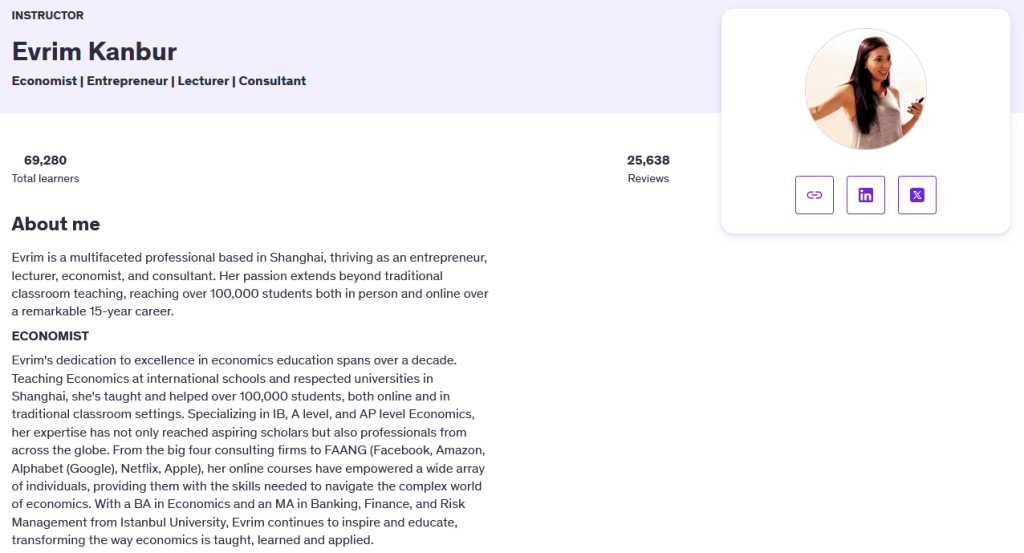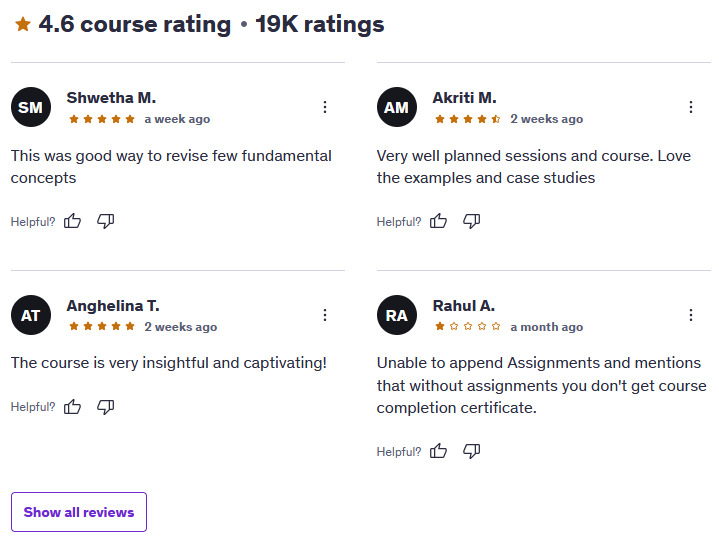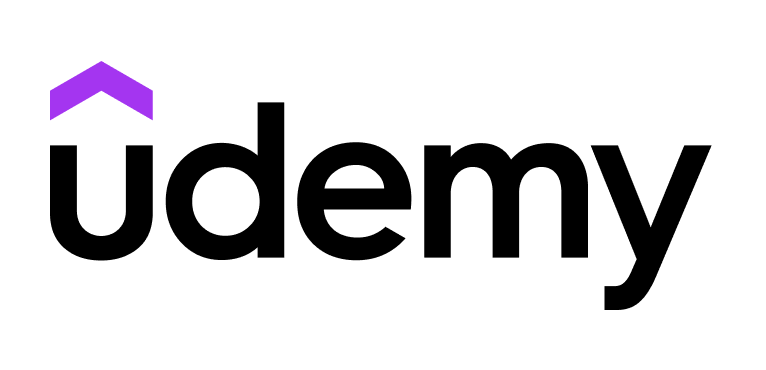If you’ve ever wanted to understand how prices fluctuate, why markets behave the way they do, or how real businesses adapt to economic shifts, then this Udemy course might be exactly what you need. Economics: Market Forces of Demand, Supply and Equilibrium is an approachable, real-world guided tour through some of the most foundational (and misunderstood) concepts in economics. And the best part? You don’t need an econ degree to get started. Whether you’re a curious professional, a student prepping for exams, or just someone who finally wants to “get” supply and demand, this course makes the learning process practical and surprisingly enjoyable.
Instructor Reputation
When it comes to learning complex topics like economics, the instructor makes all the difference—and Evrim Kanbur is one of those rare educators who brings both academic rigor and real-world savvy to the table. Her resume reads like a greatest hits of global business and education, combining stints at top firms, teaching roles at elite institutions, and hands-on entrepreneurial ventures. That diversity of experience translates beautifully into her teaching.

Evrim started her journey with a BA in Economics and followed it up with a master’s in Banking, Finance, and Risk Management from Istanbul University—so the academic foundation is rock-solid. But what really stands out is how she’s constantly evolving. She studied Strategic Marketing Management at Oxford and is currently taking on Computer Science studies at Harvard. That lifelong learner mindset clearly influences the way she teaches—she’s always updating, always improving.
Her corporate background includes high-stakes positions at Deloitte, Riot Games, and in financial institutions like IS Investment and the Istanbul Stock Exchange. In other words, she’s not just teaching economic theory—she’s been in the trenches applying it. From auditing financial statements to leading business development in the hyper-competitive gaming and fintech spaces, Evrim has seen firsthand how market forces operate in real life.
On the academic side, she’s taught over 100,000 students through online and in-person formats across the globe. She’s been a key contributor to programs at Shanghai Jiatong University, Skema Business School, and Alibaba Business School, and regularly delivers keynote speeches—including a TEDx talk that reached half a million people via livestream. Whether it’s in a university classroom or a corporate boardroom, she knows how to connect with her audience.
Even more impressive? Evrim’s teaching style is approachable, grounded, and highly engaging. Students consistently praise her for making economics “comprehensive and interesting,” with clear explanations and relevant examples. Her real-world experience allows her to go beyond dry theory, showing you how demand, supply, and equilibrium actually play out in industries ranging from tech to retail. She doesn’t just tell you the concepts—she shows you how they work.
Bottom line: Evrim Kanbur is the kind of instructor who brings economics to life. Her unique combination of expertise, passion, and global insight makes her one of the most well-rounded and qualified educators you’ll find on Udemy.
Course Structure
One of the biggest highlights of Economics: Market Forces of Demand, Supply and Equilibrium is how thoughtfully it’s structured. Economics can easily become overwhelming if you’re just thrown into graphs and jargon—but this course guides you step-by-step, making sure you actually understand and absorb the material before moving forward.

The course is divided into eight core sections, each designed to build on the last. It kicks off with the basics—introducing key concepts like demand and supply—before gradually moving into more complex areas like elasticity, shifts in market equilibrium, and how external events impact prices and behavior. Each concept is explained using real-world examples, with a strong focus on application rather than just theory.
What makes the structure particularly effective is the layered approach. You’re not just bombarded with information all at once. Instead, you progress through small, manageable units that allow you to reflect, absorb, and apply what you’ve learned. This is especially helpful for beginners or those returning to economics after a long break.
The video content is cleanly produced, with clear visuals, professional narration, and great pacing. The average video length is short enough to keep your attention but long enough to fully explain each idea. The visuals—especially the charts and diagrams—are intuitive and easy to follow, even if you’re seeing them for the first time.
Each section wraps up with interactive quizzes to reinforce your understanding. These aren’t just throwaway multiple-choice questions either—they’re well-crafted assessments that help you review key points and highlight areas where you might need a little more practice. You also get access to downloadable materials, including lecture slides, articles, and case study breakdowns for further reading.
One major strength of this course is its inclusion of real-life case studies. These aren’t vague, surface-level stories—they’re detailed, contextual examples from different industries and countries. You’ll see how an e-commerce platform in China adapts to shifts in supply, or how a sudden change in consumer behavior affects a global brand’s pricing strategy. These case studies don’t just make the material more engaging—they help you internalize how economic forces shape actual business decisions.
Lastly, the course ends with a final assignment designed to tie everything together. It’s a nice touch that helps simulate a real-world application of what you’ve learned, and gives you a small but satisfying sense of accomplishment.
Whether you’re a student studying for an exam, a business professional trying to sharpen your market sense, or a total beginner who’s just curious about how economies work—this structure makes the learning experience both smooth and enjoyable.
Content Quality
When it comes to content quality, this course delivers way beyond expectations. The material is not only accurate and well-researched, but also incredibly well-packaged for learners of all backgrounds. Whether you’re a business executive looking to sharpen your strategic thinking, a university student tackling econ for the first time, or someone who’s just curious about how prices and markets work, the content feels tailored for you.

First, let’s talk clarity. Economic concepts like elasticity, price ceilings, or market equilibrium can easily become abstract or math-heavy, but here, everything is broken down into digestible, real-world terms. Evrim Kanbur uses simple analogies, visual aids, and even humor to explain how supply and demand interact—so you’re never left scratching your head. The content avoids jargon overload and instead emphasizes understanding over memorization.
The video production quality is another strong point. Everything looks polished and professional. Graphics are clean and purposeful—especially the diagrams and supply/demand charts, which are key to grasping the subject. The narration is smooth and engaging, striking a balance between being energetic and educational. Unlike some dry lecture-style videos, these lessons are dynamic and thoughtfully paced.
Another major plus is the diversity of formats. You’re not stuck in a “watch and forget” loop. The course incorporates quizzes, downloadable slides, real-world case studies, and application-based assignments. This multi-modal approach caters to different learning styles and helps reinforce concepts. Whether you’re someone who prefers watching, reading, or doing—there’s something here for you.
The case studies deserve a spotlight. These aren’t just filler examples—they’re carefully selected stories from different sectors (tech, retail, global trade, etc.) that show how supply and demand actually play out in day-to-day business decisions. By examining how companies respond to market fluctuations, you’ll start to think like an economist without even realizing it. These case studies bridge the gap between theory and application in a way that’s often missing in standard econ courses.
Feedback from other students also echoes this sentiment—many rave about how the course helped them finally understand economics after years of struggling in traditional academic settings. Several even mention how the lessons improved their critical thinking in business or investment decisions.
All in all, the course content is rich, thoughtfully organized, and packed with value. It goes beyond textbook learning to offer practical insight into how the real world operates economically—exactly what you’d want in a course about market forces.
Overall Course Rating – 9/10
If you’re looking for a course that makes economics not just understandable but useful in the real world, then this is a great pick. After thoroughly exploring the lessons, case studies, and materials, I’d confidently rate Economics: Market Forces of Demand, Supply and Equilibrium a 9 out of 10. It’s well-designed, packed with real-life examples, and led by an instructor whose experience adds real credibility to every topic.

One of the biggest strengths of this course is how it stays balanced. It’s educational without being overwhelming, simplified without being superficial. Whether you’re a complete newbie or someone with prior exposure to economics, you’ll find the content refreshing and insightful. There’s a steady progression from foundational topics to more complex ideas, and the constant use of real-world examples keeps things grounded in reality.
Another reason this course scores so highly is its accessibility. You don’t need to have a background in math-heavy economics or finance to keep up. Evrim’s explanations are clear and grounded in everyday language. She frequently uses practical business situations to illustrate her points—like how a company might respond to changes in consumer demand, or how pricing strategies are influenced by market shifts. This makes the course not only informative but also actionable—you can actually apply what you learn.
And let’s not forget the overall experience. From the production quality to the thoughtful lesson structure, the user experience is smooth and enjoyable. There are no long, monotonous lectures. Instead, you get compact lessons, helpful recaps, quizzes to check your understanding, and a final assignment to tie it all together. Everything feels intentional and well thought out.
If I had to nitpick, some students who already have a strong economics background might find the early sections a bit slow—but that’s a minor issue considering the course’s aim to be beginner-friendly. In fact, that’s part of its charm—it doesn’t assume prior knowledge and still manages to pack in plenty of depth as the lessons progress.
In summary, this is one of those rare online courses that combines academic quality with real-world relevance. It’s not just about learning definitions—it’s about understanding why markets behave the way they do, and what that means for you as a student, professional, or decision-maker. If you want a solid grounding in market forces without falling asleep halfway through the lecture, this is the course for you.



